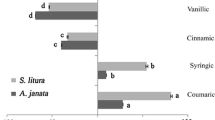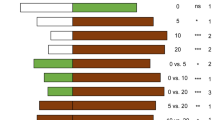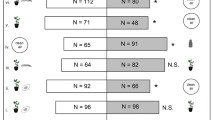Abstract
Phenolic compounds play a major role in the plant defense mechanisms and often offer protection from the feeding herbivore. They also constitute a major chemical component of many agriculturally important crops. We examined the effects of 23 common phenolic acids on the orientation and ovipositional behavior of the egg parasitoid, Trichogramma chilonis Ishii (Hymenoptera: Trichogrammatidae). The study was conducted in order to investigate the function of these compounds in the plant indirect defense. Parasitoids attractions towards the phenolics that are volatile in nature were observed by using culture tube bioassays. In addition in the Y- tube olfactometer experiments, T. chilonis were shown to be attracted towards the treatments of syringic, pyrocatechol, coumaric and quercetin at minimum dose of 10 μg and genistein, chlorogenic, vanillic, chlorobenzoic, sinapic, ellagic, protocatechuic, keampferol, tannic, caffeic, and luteolin at 30 μg and ferulic, epicatechin and gallic acid at 50 μg doses. Further experiments to examine the effect of phenolic compounds on parasitization by T. chilonis females were carried out using petri dish and artificial plant models. Among the tested compounds, syringic acid and quercetin recorded the highest percentage parasitization followed by coumaric acid and pyrocatechol. These results might imply that parasitoid attractant phenolic compounds when induced in engineered plants can further be used as cues by the egg parasitoids with potential application in biocontrol strategies.




Similar content being viewed by others
References
Ananthakrishnan TN (1992) Dimensions of insect-plant interactions. Oxford and IBH publishing C. Pvt. Ltd, New Delhi
Archna SAK, Paul AVN, Jain A (2009) Synomonal effect of nine varieties and one culture of rice on Trichogramma japonicum Ashmead and Trichogramma chilonis (Ishii) (hymenoptera: Trichogrammatidae). Acta Entomol Sin 52:656–664
Atteyat M, Abu-Romann S, Abu-Darwish M, Ghabeish I (2012) Impact of flavonoids against woolly apple aphid, Eriosoma lanigerum (Hausmann) and its sole parasitoid, Aphelinus mali (Hald.). J Agric Sci 4:227–236
Bai S, Wand Z, He K, Im D (2011) Olfactory response of Trichogramma ostriniae (hymenoptera:Trichogrammatidae) to volatiles emitted by Mungbean plants. Agric Sci China 10:560–565
Bi JL, Felton GW, Murphy JB, Howles PA, Dixon RA, Lamb CJ (1997) Do plant phenolics confer resistance to specialist and generalist insect herbivores? J Agric Food Chem 45:4500–4504
Boo KS, Yang JP (1998) Olfactory response of Trichogramma chilonis to Capsicum annum. J Asia-Pacific Entomol 1:123–129
Dicke M (1994) Why do plants “talk”? Chemoecology 5-6(3-4):159–165
Dicke M, Sabelis MW, Takabayashi J, Bruin J, Posthumus MA (1990) Plant strategies of manipulating predator-prey interactions through allelochemicals: prospects for application in pest control. J Chem Ecol 16:3091–3118
Edreva AM, Velikova V, Tsonev T (2007) Phenylamides in plants. Russ J Plant Physiol 54:287–301
Gershenzon J, Dudareva N (2007) The function of terpene natural products in the natural world. Nat Chem Biol 3:408–414
Goławska S, Kapusta I, Lukasik I, Wójcicka A (2008) Effect of phenolics on the pea aphid, Acyrthosiphon pisum (Harris) population on Pisum sativum L. (Fabaceae). Pesticides (3–4):71–77
Gols R, Harvey JA (2009) Plant-mediated effects in the Brassicaceae on the performance and behaviour of parasitoids. Phytochem Rev 8:187–206
Grant GG, Langevin D (2002) Structure-activity relationships of phenolic and nonphenolic aromatic acids as oviposition stimuli for the spruce budworm, Choristoneura fumiferana (Lepidoptera: Tortricidae). IOBC WPRS Bull 25:307–314
Green PWC, Stevenson PC, Simmonds MSJ, Sharma HC (2003) Phenolic compounds on the pod-surface of pigeonpea, Cajanus cajan, mediate feeding behavior of Helicoverpa armigera larvae. J Chem Ecol 29:811–821
Hare JD (1996) Priming Aphytis: behavioral modification of host selection by exposure too synthetic contact kairomone. Entomol Exp Appl 78:263–269
Haviola S, Kapari L, Ossipov V, Rantala M, Ruuhola T, Haukioja E (2007) Foliar phenolics are differently associated with Epirrita autumna growth and immunocompetence. J Chem Ecol 33:1013–1023
Hilker M, Fatouros NE (2015) Plant responses to insect egg deposition. Annu Rev Entomol 60:493–515
Karban R, Baldwin IT (1997) Induced responses to herbivory. The University of Chicago Press, Chicago
Kessler A, Baldwin IT (2001) Defensive function of herbivore-induced plant volatile emissions in nature. Science 291:2141–2144
Kessler A, Baldwin IT (2004) Herbivore-induced plant vaccination. Part I. The orchestration of plant defenses in nature and their fitness consequences in the wild tobacco Nicotiana attenuata. Plant J 38:639–649
Lattanzio V, Lattanzio VMT, Cardinali A (2006) Role of phenolic in the resistance mechanisms of plants against fungal pathogens and insects. In: Imperato F (ed) Phytochemistry: advances in research. Research Signpost, Kerala, pp 23–67
Lempa K, Agrawal AA, Salminen JP, Turunen T, Ossipov V, Ossipova S, Haukioja E, Pihlaja K (2004) Rapid herbivore-induced changes in mountain birch phenolics and nutritive compounds and their effects on performance of the major defoliator, Epirrita autumnata. J Chem Ecol 30:303–321
Mesbah H, Saad A, Mourad A, Taman F, Mohamed I (2007) Biological performance of quercetin on the cotton leaf-worm larvae, Spodoptera littoralis Boisd.(Lep.,Noctuidae) and prevailing natural enemies in the Egyptian cotton fields. Commun Agric Appl Biol Sci 72:611–622
Mithofer A, Boland W (2012) Plant defense against herbivores: chemical aspects. Annu Rev Plant Biol 63:431–450
Mumm R, Hilker M (2006) Direct and indirect chemical defence of pine against folivorous insects. Trends Plant Sci 1:351–358
Muthu C, Baskar K, Ignacimuthu S, Al-Khaliel AS (2013) Ovicidal and oviposition deterrent activities of the flavonoid pectolinaringenin from Clerodendrum phlomidis against Earias vittella. Phytoparasitica 41(4):365–372
Nishida R (1995) Oviposition stimulants of swallowtail butterflies. In: Scriber JM, Tsubaki Y, Lederhouse RC (eds) Swallowtail butterflies: their ecology and evolutionary biology. Scientific Publishers, Gainesville
Padmavathi C, Paul AVN (1998) Saturated hydrocarbons as kairomonal source for the egg parasitoid, Trichogramma chilonis Ishii (Hym., Trichogrammatidae). J Appl Entomol 122:29–32
Pare PW, Tumlinson JH (1999) Plant volatiles as a defense against insect herbivores. Plant Physiol 121:325–331
Peñaflor MFGV, Erb M, Miranda LA, Werneburg AG, Bent JMS (2011) Herbivore-induced plant volatiles can serve as host location cues for a generalist and a specialist egg parasitoid. J Chem Ecol 37:1304–1313
Pratyusha S, Usha Rani P (2013) Induction of phenolic acids and metals in Arachis hypogea L. plants due to feeding of three lepidopteran pests. Arth Plant Int 7:517–525
Roininen H, Price PW, Julkunen-Tiitto R, Tahvanainen J, Hurd PD, Smith DR, Burks BD (1979) Catalog of hymenoptera in America north of Mexico. Smithsonian Institution Press, Washington, DC
Romeis J, Babendreier D, Wäckers FL, Shanower TG (2005) Habitat and plant specificity of Trichogramma egg parasitoids - underlying mechanisms and implications. Basics and Appl Ecol 6:215–236
Romies J, Shanower TG, Zebitz CPW (1999) Trichogramma egg parasitism of Helicoverpa armigera on pigeonpea and sorghum in southern India. Entomol Exp Appl 90:69–81
Saini RK, Hassanali A (1992) Olfactory sensitivity of tsetse to phenolic kairomones. Insect Sci Appl 13:95–104
Scutareanu P, Drukker B, Bruin J, Posthumus MA, Sabelis MW (1997) Volatiles from Psylla-infested pear trees and their possible involvement in attraction of anthocorid predators. J Chem Ecol 23:2241–2260
Simmonds MSJ, Stevenson PC (2001) Effects of isoflavonoids from Cicer on larvae of Helicoverpa. J Chem Ecol 27:965–977
Suckling DM, Twidle AM, Gibb AR, Manning LM, Mitchell VJ, Sullivan TE, Wee SL, El-Sayed AM (2012) Volatiles from apple trees infested with light brown apple moth larvae attract the parasitoid Dolochogenidia tasmanica. J Agric Food Chem 60:9562–9566
Turlings TC, Tumlinson JH, Lewis WJ (1990) Exploitation of herbivore-induced plant odors by host-seeking parasitic wasps. Science 250:1251–1253
Urrea-Bulla A, Suárez MM, Moreno-Murillo B (2004) Biological activity of phenolic compounds from Alchornea glandulosa. Fitoterapia 75:392–394
Usha Rani P, Jyothsna Y (2010) Biochemical and enzymatic changes in rice plants as a mechanism of defense. Acta Physiol Plant 32:695–701
Usha Rani P, Lakshmi Narayana M (2008) Defense mechanisms in plants – their use as biotechnological approach for the management of insect pests. Pestic Res J 20:33–38
Usha Rani P, Pratyusha S (2013) Defensive role of Gossypium hirusutum L. antioxidative enzymes and phenolic acids in response to Spodoptera litura F. feeding. J Asia Pac Entomol 16:131–136
Usha Rani P, Pratyusha S (2014) Role of castor plant phenolics on performance of its two herbivores and their impact on egg parasitoid behaviour. BioControl 59:513–524
Usha Rani P, Sandhyarani K (2012) Specificity of systemically released rice stem volatiles on egg parasitoid, Trichogramma japonicum Ashmead behavior. J Appl Entomol 136:749–760
Usha Rani P, Jyothsna Y, Lakshminarayana M (2008) Host and non-host plant volatiles on oviposition and orientation behaviour of Trichogramma Chilonis Ishii. J Biopesticides 1:62–68
Vermerris W, Nicholson RL (2008) Phenolic Compound Biochemistry. Chapter 2, Chemical properties of phenolic compounds
Vogler U, Rott AS, Gessler C, Dorn S (2009) Terpene-mediated parasitoid host location behavior on transgenic and classically bred apple genotypes. J Agric Food Chem 57:6630–6635
War AR, Paulraj MG, Buhroo AA, Ahmad T, Hussain B, Ignacimuthu S, Sharma HC (2012) Mechanisms of plant defense against insect herbivores. Plant Signal Behav 7:1306–1320
Zhang PJ, Zheng SJ, Van Loon JJA, Boland W, David A, Mumm R, Dicke M (2009) Whiteflies interfere with indirect plant defense against spider mites in lima bean. Proc Natl Acad Sci U S A 106:21202–21207
Acknowledgements
Authors are grateful to Dr. S. Chandrasekhar, Director, CSIR-Indian Institute of Chemical Technology) for the facilities.
Author information
Authors and Affiliations
Corresponding author
Rights and permissions
About this article
Cite this article
Rani, P.U., Sambangi, P. & Sandhyarani, K. Impact of Plant Phenolics as Semiochemicals on the Performance of Trichogramma chilonis Ishii. J Insect Behav 30, 16–31 (2017). https://doi.org/10.1007/s10905-016-9595-8
Revised:
Accepted:
Published:
Issue Date:
DOI: https://doi.org/10.1007/s10905-016-9595-8




